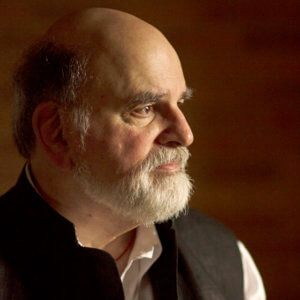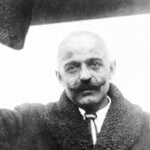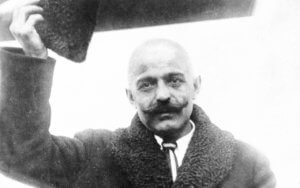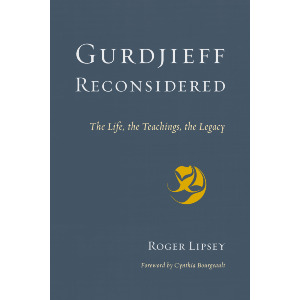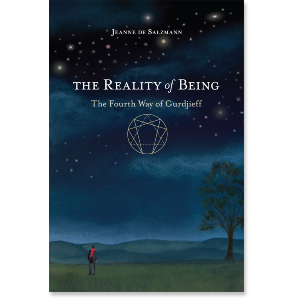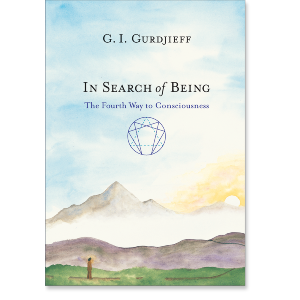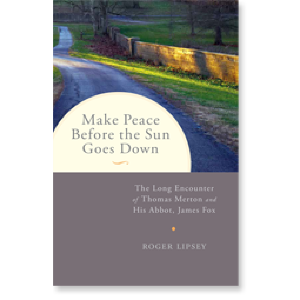An Excerpt from Gurdjieff Reconsidered
I make a point of visiting her bookstore, the ideal Parisian bookstore if you care for old editions, rarities, surprises. Widow of a well-respected poet, she presides with touching goodwill over history and taste in the form of books, thousands of books, shelves and stacks of books and journals. A relaxing, joyful place—a place of memory. One day I asked how she would respond were I to say just one word: Gurdjieff. “Disparu! Éteint!” she replied, as if tamping down a lid. “Vanished! Extinguished!” She hadn’t heard anything about him in years. The last sign of life she could recall was in the late 1970s when the director Peter Brook’s film version of Gurdjieff’s autobiography, Meetings with Remarkable Men, had attracted interest among thoughtful people. It was an essential outing to see the much-discussed film. But that died away, she said, and the rest was silence. She was surprised when I told her that there is a flourishing though largely unpublicized Institut G.I. Gurdjieff in Paris, linked to similar foundations and societies nearly worldwide. Surprised but not interested. Gurdjieff and the teaching that bears his name are now all but sealed off from both mainstream history and current concern. There are too many things to care about in our immensely troubled world. Why would one care about Gurdjieff?
This book reconsiders that question as fully as possible, no stone unturned, no grain of sand unexamined for whatever small message may be inscribed on it. But what is a reconsideration? The word generally promises either the refinement of an existing reputation or a radical break from received opinion. The reconsideration in these pages has features of both types because two unlike views of Gurdjieff and his teaching have never mingled; they have glared at each other. We must look at them both. With meticulous respect for sources, I hope to redraw in part the portrait of Gurdjieff from decade to decade of his life in the West. If all goes well, that will be a refinement. I wish also to display, question, and break the received opinions on Gurdjieff, opinions that have revolved for many years around a small number of stereotypes and that find their way casually, as if there were nothing more to say, into review articles, biographies of other figures, and cultural commentaries. It is long past time for Gurdjieff and his teaching to be better understood. We trail him behind us rather than carry him forward.
Apart from Gurdjieff’s own writings, music, and choreography, which we will explore, there is an informed, attractive literature written by two generations of his students. Among many authors, I think at once of P. D. Ouspensky and of Thomas and Olga de Hartmann for the earlier years in Russia and the hard emigration to Western Europe; of Fritz Peters and Tcheslaw Tchekhovitch for the 1920s, when Gurdjieff was director of his institute near Fontainebleau; of Solita Solano, Kathryn Hulme, and Margaret Anderson for the 1930s, when Gurdjieff was living modestly in Paris and teaching only a few students; of René Zuber, Kenneth Walker, and J. G. and Elizabeth Bennett for the post-war 1940s, when American and British followers of Gurdjieff could at last rejoin the French whom Gurdjieff had regularly seen throughout the war and Nazi occupation. To those who found their way to him in those late years—he died in 1949—he offered unique experiences virtually on a daily basis. Whether they recognized it or not, they must have offered him the solace of knowing that his efforts since he had begun teaching in Russia, in 1912, might just flower in future generations. I should add that Paris was not the only locus of Gurdjieff’s activity; he made numerous trips to New York City and on occasion other American places, engaging the interest of Americans from the mid-1920s forward. They, in turn, wrote books when the time came to look back. There are, as well, several considerable biographies, and even a metabiography that seeks to correct perspectives and detail in prior biographies. Overall, there is a surprisingly large published literature in which Gurdjieff is central and revered, in addition to archival resources only now in part coming to light.
It is long past time for Gurdjieff and his teaching to be better understood.
In this mass of material there are countless anecdotes recording what Gurdjieff said or did at one moment or another. That will matter to us. As for Diogenes, the ancient Greek Cynic who was unmistakably one of Gurdjieff’s predecessors in attitude and teaching style, brief tales of things said or done have weight. Of Diogenes nothing but anecdotes survive, but we can know the man and still experience the pressure of his teaching through that alone. It is the same with Gurdjieff, and because at this time there are still living, direct students of Gurdjieff, and students of direct students, the informal library of anecdotes continues to grow. The meaning of some of these anecdotes or teaching tales is transparent—for example, Gurdjieff’s learned discussion of “onion soup without onions,” to which we’ll come in due course. Others are koan-like provocations that linger in one’s memory. Georgette Leblanc, the multitalented singer, actress, and companion of the playwright Maurice Maeterlinck, who came later in life to Gurdjieff’s table, once said to him, “I am almost frightened. Life rises in me like the ocean.” And he to her, “It is only a very small beginning.”
Many of those who worked with Gurdjieff have said that he was unknowable, an enigma. In case we were to miss the point, a surprising number of book titles start there—René Zuber’s Who Are You, Mr. Gurdjieff?, Margaret Anderson’s The Unknowable Gurdjieff, J. G. Bennett’s Gurdjieff: A Very Great Enigma. The most recently published account from a participant in Gurdjieff’s late years says as much: “I agreed with many others . . . in admitting that no one truly knew Mr. Gurdjieff. One can describe . . . events, anecdotes lived in his company, but the wholeness of his person remains impossible to grasp.” Yet the author of these words, François Grunwald, a psychiatrist with unimaginably keen skill in characterization, did offer something of a portrait based on his first encounter with Gurdjieff in the later 1940s: “His great black eyes, extraordinary in expression, questioned me. . . . I’ll try to depict those indescribable eyes: they revealed a serenity from which radiated intense affliction, a sort of sacred sadness, and at the same time ironic malice. One might perceive something altogether different in his eyes, although the deep suffering which so many sensed never waned.” In the course of these pages, others who knew Gurdjieff will have the same opportunity to evoke him. At some level he may remain unknowable, but like a mosaic of small photographs of a distant planet, their composite impressions cannot help but sum to a portrait.
What of the other view and literature, the one that rejects Gurdjieff and his teaching with mockery, violent righteousness, or disdain? I was struck again by its longevity, its apparent eternity, when not long ago I was innocently reading a tribute in the Financial Times, written by a highly respected British scholar of late classical and early Christian history, who happens to have a second expertise and love of fine gardening and landscape design. The article concerned a palatial garden in Turin, designed by the late Russell Page, a Briton who was a dominant influence on garden style in Great Britain, on the continent and, toward the end of his career, in the United States. Page’s book, The Education of a Gardener, is universally admired. Imagine my surprise to find, in the midst of the professor’s pastoral tribute, a bilious swerve toward Gurdjieff and his teaching.
Few of his fans now realize that Page’s landscaping related to an underlying faith. After moving to Paris he became a keen follower of the cuckoo teachings and mystic baloney of that Greek-Armenian exile from Russia, George Gurdjieff, and his assistant P. D. Ouspensky. He even married Gurdjieff’s daughter at the maestro’s request. Gurdjieff’s teachings on harmonious dancing, on healing by physical adversity and cosmic rays were stupendous nonsense, but were powerfully presented by his seductive gaze. Their stress on a hidden harmony in the universe appealed especially to Page the landscape gardener.
The assault concludes by calling Page’s views “wondrous nonsense.” The professor’s language is vastly disproportionate, nearly punitive, as if Russell Page had violated an inviolable code. The professor’s comments are wrath with no basis in knowledge. What he writes of Gurdjieff’s teaching is designed to ridicule; I scarcely recognize the teaching as he dismissively describes it—some combination of stardust, sweat, and suggestibility. What he writes of Gurdjieff himself is caricature based on a decades-old tradition of caricature passed from author to author, reviewer to reviewer, without a glance at Gurdjieff himself. Misrepresentations of this kind became something of a parlor sport, a free zone where critics could outdo one another’s scorn and condescension without fear of correction. Who was on duty, so to speak, to make the correction? The Gurdjieff teaching had long since largely abandoned public space and debate; it had its own concerns. Yet questions remain: Why is the reception of Gurdjieff and his teaching, particularly among some intellectuals—and in this instance one of earned fame—so lastingly sour? And why is Gurdjieff by and large forgotten? The questions are thoroughly explored in later pages and touched on here.
I know of Russell Page in an altogether different light. There is a striking photograph of him with Gurdjieff during a late “car trip”—Gurdjieff often assembled small caravans of students and family to visit places of interest in France. An immensely tall man, Page stands near Gurdjieff during a break in travel; obviously at ease, they clearly know each other well. Page seems to have known how to engage Gurdjieff playfully. For example, at table in the late 1940s, “Gurdjieff said he must finish the arrangements because he wanted to go in a day or two to Tibet. ‘Tibet, Monsieur?’ said Page. ‘Or Dieppe?’ Mr. G. gave him a perfectly wicked and sly smile and said, ‘Either very expensive,’ as though apart from that the destination did not matter much.” There is another photograph: Russell Page as a pall bearer at Gurdjieff’s funeral, early November 1949.
Severe or casual dismissiveness among some intellectuals then and now has a number of roots, the earliest dating to the years 1923–1924. At that time, newly established in France, Gurdjieff invited public attention by receiving visitors, including journalists, at his Institute for the Harmonious Development of Man in Fontainebleau-Avon, roughly an hour from Paris by train or car. I’ll often refer to it as the Prieuré. The Institute’s new home was a spacious manor house, the Prieuré des Basses Loges, once a convent, later the home of a royal mistress, still later owned by the principal lawyer defending Captain Alfred Dreyfus in the years around 1900. Visitors to the Prieuré were hospitably received, some spoke with the founder (through a translator at that time), others prowled the extensive grounds and learned what they could, and many witnessed Saturday evening performances of the sacred dances, for which Gurdjieff became known when he brought the dances and his hardworking troupe to the public through theatrical performances in late 1923 (Paris) and the first months of 1924 (New York City and elsewhere in the United States).
At some level he may remain unknowable, but like a mosaic of small photographs of a distant planet, their composite impressions cannot help but sum to a portrait.
Both journalists and distinguished visitors could not miss an unassailable truth: a visit to the Institute was a visit elsewhere. Its values were different, its intentions and way of life differed, and Gurdjieff himself was other; he matched no norm. Indecipherable to the majority of casual visitors, he may well have been the first authentic guru in the modern West—but what was that? The word itself was scarcely known, let alone the function of that sort of teacher. Sacred dances? Many acknowledged that they were beautiful and the performers capable of intricate movement—but why didn’t they smile? Dancers are supposed to smile. And the Institute itself, with its novel and challenging printed statement of purpose—really? Is such a school needed? Apart from obvious exceptions, aren’t adults adult, with completed identities, no fundamental reworking necessary? It was too much for most observers and, though there were exceptions, newspaper reports for the most part lurched toward entertaining distortion and condescension. Gurdjieff abandoned publicizing the Institute and his work in choreography. In later years he was typically abrupt with journalists; he wanted no part of them. Despite the mixed public reception in those early years, there were visitors who stayed, audience members who recognized in the dances and the dancers a new way of being.
The literature of rejection and disdain has another root in those years: the passage through one another’s lives of Katherine Mansfield, the now classic author, and Gurdjieff at the newly founded Institute. Chapter 4 looks more closely at this enduringly vivid and touching encounter, but something should be noted now. New Zealand-born, reaching out to and reaching London in 1908 to found her literary career, Mansfield quickly became “one of us”—friend (and sometime rival) of many in the literary elite, discovered and first published by Alfred R. Orage, editor of the leading literary journal of its time. Driven by superb powers of observation and a sharp wit, her short stories became part of the canon of twentieth-century literature. And she sickened. When she was diagnosed with tuberculosis in 1917, her life became a pilgrimage or flight from place to place, from healthy mountain air to doctors who offered some hope of a cure to quiet times in England and on the continent when she believed that all could again be well. Through her notebook for 1919 we can visit a key moment in these increasingly difficult years to hear something of her private sensibility, not yet fully revealed in her stories. Her words there will help us grasp why she found her way to Gurdjieff and the Institute in the last few months of her life: “Honesty . . . is the only thing one seems to prize beyond life, love, death, everything,” she wrote. “It alone remaineth. O those that come after me—will you believe it? At the end truth is the one thing worth having—it’s more thrilling than love, more joyful, & more passionate. It simply cannot fail. All else fails. I, at any rate, give the remainder of my life to it & it alone.”
She was drawn to the Institute because, there too, she was “one of us”—a participant by virtue of her longing for another quality of truth and experience, which she had glimpsed from time to time, and by virtue of her willingness to take herself in hand, to question herself. In the teaching cycle Gurdjieff had offered in Russia before the Revolution, he had introduced the idea of “magnetic center,” an innate capacity in some people to detect and move toward liberating truth, to look past the familiar. It is a raw, untutored capacity. Naturally it speaks the language of a given time and place, but it belongs to itself, finds its own way, answers to no one until satisfied that it has come home—however it understands “home.” Katherine Mansfield possessed such an inner compass.
Guided by Orage, who also became a resident at the Institute in its very first weeks of existence, October 1922, Mansfield left behind physical therapies that had done her no good and wished to rework her life in some new way that she understood the Institute to offer. “I am going to Fontainebleau next week to see Gurdjieff,” she wrote that month from Paris to her husband, John Middleton Murry. “Why am I going? From all I hear he is the only man who understands there is no division between the body and the spirit, who believes how they are related. You remember how I have always said doctors only treat half. And you have replied, ‘It’s up to you to do the rest’? It is. That’s true. But first I must learn how. I believe Gurdjieff can teach me.”
Mansfield came to the Prieuré on a two-week trial basis after being examined in Paris by a British doctor, one of the early residents, who confirmed to Gurdjieff that she was mortally ill with little time left. Gurdjieff understood the possible consequences of lengthening her stay, but Mansfield already had friends, among whom were the women Gurdjieff had assigned to make her life comfortable. The best account is from Tcheslaw Tchekhovitch, a mighty young man with a big heart—once a professional wrestler and circus strongman—who had accompanied Gurdjieff since meeting him in Constantinople. Tchekhovitch noticed one day that Katya (as he called her) was sad and, asking why, learned that Gurdjieff had suggested she would be better off in a sanatorium. Tchekhovitch took matters in hand: “A strange determination came over me on her behalf: not to give up, not to lose hope. I could not believe Gyorgi Ivanovich would refuse to let her stay at the Prieuré if she expressed her wish sincerely, from the depths of her being. Gently, I spoke my mind. ‘You know as well as I that Gyorgi Ivanovich is a good man. He won’t refuse, if you speak to him frankly.’ Then, wanting to provide her with a request he could not turn down, I added, ‘Don’t just ask to stay. Tell him it’s the only way for you to find true happiness.’” No doubt she put her question effectively and found allies in three women who were “not easily put off.” Tchekhovitch continued, “‘Gyorgi Ivanovich, people have already said plenty of scandalous things about you, so one more isn’t going to make much difference! We’ll share that burden with you.’ ‘All right, then,’ he said, looking at them intently. ‘So be it. We’ll all bear it together!’”
He is the only man who understands there is no division between the body and the spirit, who believes how they are related.
As Gurdjieff must have known, it was not a burden that could be shared. He alone would face opprobrium, were their Katya to die at the Prieuré. Out of sheer kindness he permitted her to stay. Letters to her husband and a conversation with Orage, later recorded by him, as well as a conversation with P. D. Ouspensky, bear witness to the joyous weeks of discovery and self-discovery, of comfort and fellowship, she experienced. No witness of the life of the Prieuré has left a more sensitive and vivid record—to be explored in chapter 4. She died suddenly on January 9, 1923; her grave in the local Avon cemetery is a few yards from the Gurdjieff family plot.
And because she was “one of us” in England, and soon enthusiastically read in French translation, anger and blame descended—as virtually everyone who cared for Gurdjieff and the Institute had anticipated. It was as if Gurdjieff had irresponsibly deprived English letters of a treasured person. Rejection and disdain had characterized much of British opinion even in advance of Mansfield’s death—newspaper reports and word-of-mouth were marching on, and the inexplicable departure to the Prieuré of A. R. Orage, such a central figure in English letters, was alarming. James Moore, author of Gurdjieff and Mansfield, makes the relevant inventory. Wyndham Lewis described Mansfield as “in the grip of the Levantine psychic shark.” D. H. Lawrence qualified the Institute as a “rotten place.” During Mansfield’s few months at the Prieuré, Vivian Eliot, the poet’s wife, reported of an acquaintance that “she is now in that asylum for the insane called La [sic] Prieuré where she does religious dances naked with Katherine Mansfield.” François Mauriac, a notable Catholic author and eventually a member of the Académie française and Nobel laureate, wrote many years after Mansfield’s death that “in the end it was to Gurdjieff, the mage, that she gave her faith, at the phalanstery of Fontainebleau, where she went to die in misery.” He was reviewing in 1959 the newly published French translation of the first comprehensive biography of Mansfield.
Particularly in France, the stain of Mansfield’s death on Gurdjieff’s reputation prevailed for decades. Conversation with the English scholar Gerri Kimber, author of a marvelous history of Mansfield’s reputation in France, led to the oddest of findings: there were two stacks of received opinion from which French intellectuals drew for decades after Mansfield’s death. In the first stack, Mansfield was depicted as an angel, a supremely refined, loving intelligence briefly cast into our world and sadly snatched away. In the second stack, Gurdjieff was depicted as a devil, an untrustworthy exploiter. Neither received opinion required further thought. The Mansfield myth survived until a series of thorough biographies, from 1953 forward, offered a much more nuanced truth: she too had her struggles and lapses, not only where health was concerned. The Gurdjieff myth should have long since been put to rest: after 1950, anyone who cared to have unprejudiced knowledge of him could easily find a growing number of accurate sources.
Enough for now about reputation. Later chapters will return to the topic: another generation of French authors did what they could, with some success, to eliminate Gurdjieff as a figure worth serious consideration, and several authors in the English-speaking world, approaching with sharpened axes, did what they could to exclude both him and his teaching from the known world. For now, no matter—they’ll have their say later when we look at the years just after Gurdjieff’s passing. We should begin thinking about what Gurdjieff and his teaching represented. He may be unknowable but, all the same, are there no mirrors we can hold up to catch light?
Share
Related Books
$24.95 - Paperback
$27.95 - Paperback
$26.95 - Hardcover
Make Peace before the Sun Goes Down
$22.95 - Paperback
